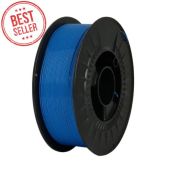We use cookies to make your experience better. Read more
18 April, 2025
TPU Filament Uses: Flexible Solutions for Complex Projects
What is TPU Filament and Why is it So Widely Used?
TPU filament, short for Thermoplastic Polyurethane, is a flexible 3D printing material that combines the strength of plastic with the elasticity of rubber. As a member of the thermoplastic elastomer (TPE) family, TPU stands out for its resilience, stretchability, and versatility across both consumer and industrial applications. Its popularity stems from the fact that it can stretch over five times its original length before breaking, making it a top choice for applications that require flexibility and durability.
Key Properties of TPU Filament
- Excellent shock absorption, impact resistance, and vibration dampening
- High elasticity and resilience
- Resistance to abrasions, oils, greases, chemicals, and low temperatures
- Moderate water resistance
- Adjustable hardness and flexibility depending on infill and filament type
Color and Printing Considerations
TPU can be printed in many colors, making it suitable for both functional and aesthetic projects. Printing TPU requires slower print speeds (5–30 mm/s), nozzle temperatures of 220°C–250°C, and optimized retraction settings for best results.
TPU Filament Uses in Industrial and Consumer Applications
- Gaskets and seals
- Shock absorbers and vibration-dampening components
- Non-marring workholding fixtures
- Flexible valves and friction pads
- Hoses, drive belts, and straps
- Protective covers and bands
- Prosthetics and orthotic components
- Sporting goods and safety equipment
Benefits for Low-Volume Production
TPU filament enables manufacturers to create custom-shaped parts in low volumes without the added cost and delay of traditional tooling. This is ideal for prototypes or one-off items that would be economically unfeasible using injection molding.
Material Properties That Make TPU So Valuable
- High elasticity and resilience
- Tear, abrasion, and impact resistance
- Performance at low temperatures
- Flexibility without added plasticizers
- Excellent compression set and weather resistance
Real-World Use Cases
Softer TPU grades are used for tubing or soft-grip handles, while harder variants suit more rigid components like caster wheels. Its reliability under repeated stress makes it popular in medical and automotive sectors.
Challenges of Printing with TPU and How to Overcome Them
- Use a direct-drive extruder for best results
- Keep print speeds low (20–30 mm/s)
- Nozzle temperature: 220°C–250°C; heated bed: 40°C–60°C
- Minimize or disable retraction
- Improve bed adhesion with glue stick, painter’s tape, or textured beds
Moisture Control and Print Quality
TPU is hygroscopic and should be stored in an airtight container with desiccants or dried before printing to avoid bubbles and inconsistent extrusion.
Post-Processing and Handling of TPU Prints
TPU parts can be trimmed or cut with scissors or hobby knives, and sanded with fine-grit sandpaper. For assembly, use adhesives made for plastics.
Long-Term Performance
TPU’s flexibility makes it suitable for living hinges, bendable joints, and components requiring frequent motion, with durability that outperforms many other 3D printed materials.
Comparing TPU to Other Filaments
While PLA and ABS are easier to print and more rigid, they lack the flexibility of TPU. TPU is preferred for applications that require elasticity and durability, especially in industrial settings.
Why TPU Filament Remains an Industry Standard
TPU filament is popular due to its unique properties: elasticity, durability, and chemical resistance, making it ideal for custom medical equipment, rugged mechanical parts, and more.
Our Offer at 3D Trček
If you need parts that require flexibility, strength, and longevity, TPU filament is an excellent choice. 3D Trček specializes in processing a wide range of thermoplastics, including TPU, and can support your project from material selection to final product.
Comment(s)



Please complete your information below to login.
Sign In
Create New Account